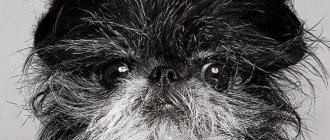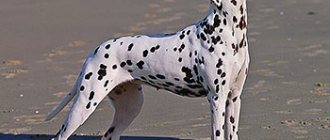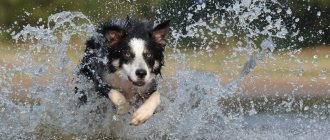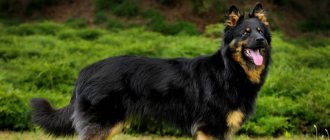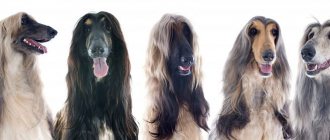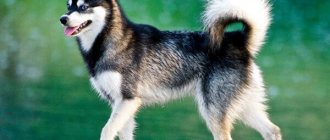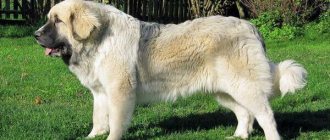Origin story
Hortyhounds were bred on the Black Sea steppes of Asia. Their genus dates back to the mid-19th century, but for a long time the breed was used as a commercial breed and had no pedigree. Horty greyhounds were first described in the documentary works of P.M. Gubin (1801) and P.M. Machevarianov (1876). The specifics of hunting in the steppes required the work of an appropriate type of greyhound, which would specialize in foxes, hares and saigas.
When creating the breed, dog breeders paid attention, first of all, to the working characteristics of the dogs, and not to their exterior. The dog was valued for its ability to mark, overtake and capture a cunning and cautious animal that could move very quickly.
This explains the fact that the bulk of greyhounds were represented by mestizos, who did not have pedigrees, but had excellent working characteristics. The Horta Greyhound standard was compiled by K.M. Esmont and A.V. Lerche closer to the middle of the 20th century. Only the efforts of enthusiasts made it possible to significantly increase the number of the breed. But in 1923, the total extermination of the Russian Horty dogs followed, and during the Second World War, only a few of these dogs remained. But only using these preserved specimens was it possible to preserve and revive the breed.
Hunting
The Hortai Greyhound belongs to the bloodline of eastern pickling dogs. The breed is distinguished by several features, but the main one is its undying popularity for use in hunting. Such results were achieved thanks to a demanding selection process, which always placed performance qualities at the forefront. Thanks to their speed and agility, hortykhs are used for fishing for:
- To the hare.
- Fur-bearing animal.
- Small and medium-sized ungulates.
- With appropriate preparation and data - wild cats and wolves.
Shorthounds work in almost any weather conditions; difficult terrain is also not an obstacle. The fact is that in each region, depending on the assigned tasks, their own types of Hortyhounds have been bred, which comply with the standard, but are “tailored” for certain types of work.
Shorthounds are valued for their intelligence and ability to gain experience in hunting. Dogs are taken to the fields at a young age, giving the young animals the opportunity to learn from experienced, older dogs. Horty owners with extensive experience note that puppies born from working parents have “innate” skills and even at 2–3 months of age they can easily master basic commands.
Description of the Hortaya Greyhound breed and characteristics
In many ways, the appearance of the Horta Greyhound is similar to the standard exterior of greyhounds. It is characterized by a strong, moderately narrow body. Height of males – 65-75 cm and above, females – 61-71 cm, weight of males – 25-35 kg, females – 18-25 kg. The head, in proportion to the body, is not large; on the skull there is a pronounced bump on the back of the head, called the “falcon”. The muzzle is narrowed and dry. The forehead is slightly sloping, neatly transitioning into a slanted nose, on which a slightly noticeable hump is allowed. The pigmentation of the nasal lobe is dark.
There is a scissor bite. The eyes are slanted, large, and their irises are characterized by different shades of brown. The ears are small and stand low, their shells are thin, and the ears themselves are located along the neck. Even if the dog is alert, their soft tips are thrown to the side or forward. The muscles on the long neck are clearly visible, but the neck itself is slightly compressed on the sides.
A strong, elongated body, a deep chest, quite spacious, oval in shape. The ribs protrude slightly, immediately behind the elbow joint, forming a barrel-shaped increase, sloping towards the abdomen. On a strong back there is a clearly visible wither, gradually lowering, turning into a hollow.
A slight convexity on the wide loin decreases closer to the tail. According to the rules, the tail lowered down is quite long, the tip is curled into a half ring. In most cases, there is no dewlap or fringe on it (or is barely pronounced). The belly is carefully selected. The limbs are long and parallel, the joints are well defined. The forearm is longer than the shoulder, and the lower leg is longer than the thigh. The hind legs stand wide and slightly pulled back. On the front legs the shape of the foot is round, and on the hind legs it is closer to oval. The feet themselves are arched, slightly compressed on the sides.
We advise you to read: Brussels Griffon Dog Breed
Although the Horta Greyhound has many features that make it similar to Greyhounds, their muscle groups are distributed and developed differently. There are also differences in the structure of the skull, especially the muzzle. This muscular structure affects the speed abilities of short greyhounds, allowing them to easily overtake even fast saigas reaching speeds of up to 90 km/h. In addition, these dogs have simply extraordinary endurance. They tirelessly chase prey throughout the daylight hours. With a commercial hunt lasting up to 3-4 weeks, greyhounds work through a full season without failure. Thanks to the streamlined body shape and lightness of the skeleton, greyhounds can reach even higher speeds than hounds. To change the balance of the body in the process of rapid movement, the dog only needs to tilt its long neck.
In an article about this breed, K.M. Esmont called their paws “iron”, because they allow the dog to fly headlong across the frozen ground without slowing down. The persistence and agility of the Horta Greyhound allows it to give a head start to a dog of any other breed - it only needs one lightning-fast throw to overtake its prey. Due to their keen vision and instant reaction, short greyhounds can distinguish prey at a fairly impressive distance of several kilometers. A wide field of vision is provided by the elongated shape of the muzzle.
As if compensation for all the phenomenal abilities, the sense of smell in dogs of the Hortai breed is not the sharpest. But the most valuable qualities in the breed have always been lightning speed of reaction, visual acuity and attentiveness.
There are a number of minor differences between the greyhound varieties of the north and south. For example, Stavropol greyhounds are more graceful, with light bones, short dewlap on the tail and hind legs, and almost no undercoat. Greyhounds from Rostov are distinguished by rough bones, high stature and slightly longer coats with a characteristic undercoat. However, all differences do not go beyond breed standards.
Breed standard
The Afghan Hound in the photo looks pampered and sophisticated. But this is a false external impression. In fact, this is a strong and well-built dog with excellent stamina. She has a lean body and long legs, allowing her to move gracefully.
The greyhound's belly is sunken. The ribs stick out well, but behind the long fur they are not visible at all. The body shape is rectangular. The hind legs are muscular, the front legs are slightly shorter and weaker. Elbow joints are well defined. Paw pads are hard.
The dog's head is small, with an elongated muzzle, at the tip of which there is a large black nose. The eyes are larger and located close to each other. The jaw is very strong, with a good correct bite.
The peculiarity of the breed is its long straight neck. Not every greyhound hunting dog can boast of such an exterior feature. Nature rewarded the “Afghan” with it for a reason. The fact is that the elongated neck allows the dog to better view the area. The tail is low on the loin, drooping down.
Hidden behind the wide, strong sternum is a strong heart, which perfectly pumps blood during the rapid movement of the animal. According to the standard, the color of the iris of an Afghan Hound dog should be dark. Acceptable nose colors are brown and brown. The dog's ears are drooping.
The peculiarity of the breed is its silky long coat. It falls down and does not curl. Light waviness is allowed. It is very pleasant to touch the fur of an Afghan hound. But it is not long on all parts of her body; for example, there is only short stubble on her muzzle.
According to the standard, the fur of such a dog cannot be snow-white. That is, the presence of light white and beige spots on the body is unacceptable. But dark and reddish speckles, on the contrary, are welcome.
In general, the fur color of an Afghan hound can be any color. The long, silky hair does not in any way prevent the dog from running quickly and making long jumps. He has a truly aristocratic appearance, refined habits and a penetrating gaze.
Coat type and color
The Short Greyhounds have a smooth coat that lies tightly on the body. It is characterized by straight hairs, without kinks, elastic, up to 2.5 cm long. The weak undercoat is almost absent in the warm season.
The color can be zonal or solid. To describe the color of the Shorthound, special terms were even introduced. In particular, the colors of these dogs come in the following types: gray and fawn (various shades), forelock, murugi, black and white with fawns, and there are also a number of colors with the so-called mazurina - the presence of an obligatory dark shade of the mask on the face and the tips of the paws in general fawn, gray or red color.
We advise you to read: Weimaraner Dog Breed
For the colors of this breed, the All-Russian Pedigree and Stud Book not only used special terms to describe the shade, but also indicated its location. This is how the names appeared: forelock white-breasted, white half-eared, black and piebald with forelock tan and others.
There are not very prominent spots on the coat, which are in harmony with the base color. When the color is solid, then, as a rule, the upper part of the body is darker in comparison with the limbs and belly.
Breed standard (appearance)
The Afghan Hound dog is not limited to a strict exterior. The breed description meets the following requirements:
- Body type. An elegant and elongated body with a lean belly and a dry, but not narrow chest.
- Paws. Long, straight shape. When running, the movements are sweeping. The pads are dense, the claws are well developed. The claws are colored depending on the color of the dog.
- Breast. Wide with well-developed muscles.
- Head. Set high, small, elongated in shape. The high location allows you to expand the view of the space during hunting.
- Neck. Long, forms an angle of 90 degrees with the body. The transition from neck to head is not pronounced.
- Muzzle. Triangular in shape, widened towards the crown and very narrowed towards the tip of the nose.
- Nose. The bridge of the nose is long and straight, sharp in shape. The lobe with thin nostrils is black or dark brown in color.
- Eyes. Almond-shaped, dark in color: from dark brown to light sand.
- Ears. Low set, triangular in shape, hanging. The tips fit snugly to the dog's head. Covered with long and thick hair.
- Tail. Low set, saber-shaped, covered with long hair. May wrap itself in a loose ring.
- Color. The standard allows any color of the Afghan Hound, but puppies with white spots are rejected. The most common color is sand or red, less common are black and white-black. Color is never differentiated by sharp transitions.
- Wool cover. The coat is guard, but soft, long and straight. Covers the entire body of the dog except the muzzle. The dog's nose is covered with short, close-lying hair. The long coat is straight, without waves or curls.
- Height at withers. The cable can reach 74 cm, females up to 69 cm. There are mini Afghan hounds whose height does not exceed 67 cm. Small representatives of the breed are not rejected and participate in exhibitions in the general ring.
- Weight. The breed is a light one and, despite its considerable growth, weighs only 20–25 kg.
By
Greyhound character
The intelligence and independence of the Horta Greyhound are distinctive qualities that are not characteristic of every breed. For short greyhounds, these characteristics are especially important, because they do not walk on the pack, but accompany the hunter at a distance of 10-15 meters, while during the pursuit of prey they can be several kilometers away from him, which, in itself, makes recoil impossible commands
The constant presence of this dog close to other animals (horses, dogs) and humans makes the presence of aggression in its character unacceptable. The extermination of aggression in the breed was carried out using a rather cruel, but effective method - a dog that showed aggression towards people was destroyed. As a result, the Horta Greyhound's temperament turned out to be so trusting that she would easily go with any stranger. The sociality of animals of this breed is extremely high, which explains their gregariousness.
Horty greyhounds living in the city absolutely retain the instincts of a hunter. This dog is brave, reckless and malicious towards animals, therefore, despite its peaceful coexistence with people and dogs of its type, it considers small animals (squirrels, cats, etc.) to be prey and is capable of attacking.
But, nevertheless, the greyhound is quite “loyal” to pets and birds, especially when they live together in a country house. The greyhound's temperament is quite restrained, and it is friendly and sociable. When young, dogs can be active and even choleric.
The Horta Greyhound does not have a territorial sense, so it is not a watchman. But excellent eyesight allows her to notice even the shadow of a stranger and bark to warn her owner. Over time, some dog breeders have learned to train Horts in such a way that they can make good guards.
From the history of the appearance of greyhounds
The greyhound dog appeared and spread throughout all countries starting from Arabia, where the breed was bred back in the times of Mesopotamia or Ancient Egypt. Scientists have found a lot of evidence that greyhounds existed back in 4000 BC. Drawings and various kinds of images were found later, and scientists found skeletons of such animals in tombs.
The breed penetrated the territory of the Caucasus along with military and trade campaigns through Afghanistan and other countries, then, over time, the famous Russian greyhound was bred on its basis. But these dogs came to Europe through Syria. It is known that even Alexander the Great loved such dogs and brought them specially from Gaul.
Pros and cons of the breed
The Hortai is a fairly rare type of greyhound; it has been bred and kept for hunting since ancient times. These dogs are mostly owned by hunters - residents of remote areas of the steppe. And the Hortai Greyhound absolutely justifies its status as a most valuable worker and friend, as well as a breadwinner responsible for supplying food to the master’s table. The value of a good greyhound in the steppe is higher than that of a good riding horse.
When raising, you should understand that this breed of dog usually lives freely in the steppe and gets used to independent actions. This leaves its mark and can lead to difficulties in training, since the pet can demonstrate stubbornness and zero reaction to commands.
From the history of the appearance of greyhounds
The greyhound dog appeared and spread throughout all countries starting from Arabia, where the breed was bred back in the times of Mesopotamia or Ancient Egypt. Scientists have found a lot of evidence that greyhounds existed back in 4000 BC. Drawings and various kinds of images were found later, and scientists found skeletons of such animals in tombs.
The breed penetrated the territory of the Caucasus along with military and trade campaigns through Afghanistan and other countries, then, over time, the famous Russian greyhound was bred on its basis. But these dogs came to Europe through Syria. It is known that even Alexander the Great loved such dogs and brought them specially from Gaul.
How to care for a Horta Greyhound?
Dogs of this breed are not demanding in care. Since they have almost no undercoat, you can use a brush or mitten for combing, without any separate devices. After a walk, a thorough inspection of your pet’s fur is required to check for ticks and fleas. If the dog lives in an apartment, then after a walk it is necessary to wash its paws. There is no need for frequent bathing - for a Horta greyhound, a complete wash 1-2 times a year is enough.
We advise you to read: Dog Breed English Bulldog
Nail trimming is not required, especially if the dog often runs on hard surfaces. But from the very beginning it is worth teaching the puppy to brush his teeth, since their health is valued not only in specimens going to the exhibition, but teeth also represent an important working tool for this breed.
Interesting facts about Horta
It is believed that the birthplace of all greyhounds is the Middle East, Arabia and Egypt.
Interestingly, the subjects of the pharaohs were convinced that the god Anubis accompanies the souls of the dead to the kingdom of the dead. The Egyptians depicted him with the body of a man and a head similar to that of a jackal or a greyhound dog. According to the second version, greyhounds were pets of a very mysterious people. The ancient Greeks called them Scythians. Traces of the Scythians are found in vast territories, from Altai to the Danube. On the gold jewelry of the Scythians, dogs were depicted very similar to modern Horts. “Greyhound breeders” - greyhound breeders - have their own language. It is replete with terms that at first glance seem not entirely clear. For example, a special rope like a leash is called a “pack”. It can be used to restrain several greyhounds. And the fur of greyhounds is called “dog fur.”
Field leisure of Horty greyhounds and hunting
The dog of this breed is a steppe hunter. The field leisure time of the Hort greyhounds is quite active - they go with her to fox, saiga, hare and wolf. The incredible endurance of this dog allows it to work literally from morning to night. Compared to its “closest relatives”, it can catch up with the beast at long distances - 4 km or more. And to repeat such a “race” again, she only needs to rest a little after the first. To hunt a small animal, the Hort greyhound can be used alone, but a pack of greyhounds is used to hunt antelope, wolves and various large ungulates.
The Hortai greyhound instantly strangles a small animal immediately after it catches it, and holds a large one until the hunters arrive. At the same time, the division of food and hunting instincts in the short greyhounds is quite clear - having taken prey, the dog will not tear it or eat it, but will wait until the owner takes it. This indicates a flexible nervous system, allowing the greyhound to quickly calm down.
CONTENT
In his homeland, he is still a hunter living in the steppe. With the horta they hunt hares, wolves, foxes, and saiga. She is incredibly resilient and can work from morning until night. Unlike whippets and greyhounds, it is capable of chasing an animal over a long distance of up to 4 km or more. Moreover, after a short rest she is able to repeat it. Unlike most greyhounds, it hunts using scent, not just sight.
They are used alone when hunting small animals, or in a pack when hunting wolves, antelopes and other ungulates. She catches and strangles small animals instantly, and holds large ones until the hunters arrive. Like retrievers, it does not tear apart its prey, since it often hunts animals that have valuable fur.
The Horty's coat It has a self-cleaning structure and dogs practically do not get dirty. Upon arrival from a walk, they shook themselves off and were already clean. In the house, of course, there are hairs from the pet, but during the molting period. Then you will need to brush your dog frequently. Do all procedures while walking to avoid excess hair in the house. Puffers are not suitable for short-haired dogs. It is best to purchase devices made of elastic, rubber, rubber or silicone materials. Brushes can be of various configurations. In the form of a glove, with long handles, worn on the hand, with teeth of different lengths. Special configurations and soft materials allow you to effectively remove dead hair and also massage the dog’s body. Hortys are not bathed often. All detergent concentrates must be selected according to the pet’s coat type and diluted with water so as not to disturb the PH balance of the skin. By applying shampoo in its pure form, you can greatly degrease your skin and coat. The skin will become sensitive and dandruff or even eczema will appear, and the dog’s “coat” will lose its shine.- teeth
are its weapon. In order for the Hortai to hunt for a long time, they must be in excellent condition. After all, if your teeth hurt or your gums bleed, the dog is unlikely to want to catch a hare, even if it catches up with him. The first sign of diseases in the oral cavity is a pungent odor from the pet's mouth. This means that there is a stone on the teeth in which there is a large accumulation of bacteria. The products of their vital activity create the stench. If stones are found, they must be removed quickly by a veterinarian. Do not pick at the animal’s mouth yourself, especially with metal objects. Firstly, the instrument is not disinfected. You can not only damage the enamel, but also scratch your gums and introduce dirt. The veterinarian gives the dog an immobilizing injection and removes the tartar using ultrasound. Don't run your dog's teeth. Teach her to clean her from childhood with flavoring pastes for animals, which also have bactericidal properties and remove odor and plaque. Plaque prevention will be provided by special “chews” for dogs. These can be edible, pressed seeds. - ears
will be in excellent condition if you take care of them. Firstly, these are regular checks. Secondly, cleaning is only necessary when they are dirty. There are herbal remedies for this. They will perfectly soften stagnant dirt, create a disinfecting effect and have a beneficial effect on the skin. Basically, they are instilled into the ears and wiped off after a short period of time.
After going hunting or in nature, check your eyes The dog runs at high speed and can run into branches and thorns. Therefore, mechanical injuries are possible. If the eyes are irritated by foreign particles, they need to be washed. Take a bactericidal, soothing agent and thoroughly soak a cotton pad with it. Next, wipe your eye with light movements towards the inner corner, each time changing the disk to a clean one. Mechanical injuries should not be left to chance and treated personally, so as not to deprive your pet of vision. Only a veterinary ophthalmologist can determine the complexity of the situation and prescribe procedures.
Active greyhounds almost always grind their claws But, if they are longer than expected, shorten the length with claw clippers or a file.- Feeding
is acceptable both natural and ready-made. It is best to tell you how to prepare and select the composition of a natural diet from a veterinarian or the breeder of the nursery where you bought your pet. But we can say for sure that natural food is mostly beef meat. You can feed your dog ready-made food, but it must be professionally produced. Greyhound dogs should not be overfed. Can you imagine how such an active dog can run around with extra pounds? What a tremendous strain this puts on the heart, ligaments and joints! - Walks
The best greyhounds are movement and movement again. If you walk your pet for an hour or two a day, then on weekends you need to take it out into the field for several hours, regardless of the weather. There the animal will be able to frolic and run around to its heart's content. Remember that while running he will not listen to your commands. Therefore, before you let your dog go “free swimming”, make sure that nothing threatens it.
Photos of Horta Greyhound
Feeding rules
Short greyhounds are genetically endowed with a high metabolic rate, which ensures energy supply to all organs and, in particular, muscle tissue. Therefore, food should contain foods with high calorie content - carbohydrates in the form of cereals, flour products (bread). Porridges are well boiled, but coarse ones, such as oatmeal, are given only crushed.
Young and adult dogs need raw meat and canned meat for plastic processes. Both carcasses of small animals - gophers, for example, as well as offal and animal fat are suitable for feeding. Greyhounds do not digest pork well, so the amount should be limited or completely eliminated.
The diet should be supplemented with vegetables - potatoes, carrots, beets, cabbage. It is advisable to alternate vegetables. Greens are introduced into the food - beet and carrot tops, young scalded nettles. The food should be liquid - porridge is poured with milk, buttermilk, whey. Dogs are also given other dairy products - cottage cheese, hard cheese.
Strong bones and healthy teeth are formed with sufficient amounts of phosphorus and calcium. Vitamins, micro- and macroelements should be included in the greyhound’s diet not only with food (bone meal, fish, bones), but also in the form of mineral and vitamin supplements, rock salt. Food should be warm and fresh. The dog should always have fresh water.
If the owner does not have the opportunity to cook for his pet himself, he can feed him ready-made diets. The best option is premium and super-premium category food. They have a balanced composition and do not require additional feeding with vitamins and minerals. The only thing the owner needs is to provide the pet with constant access to water.
Price and owner reviews
The price of a Horta Greyhound depends on the pedigree and purpose. If you are not keen on hunting, the puppy should be taken from a representative family, not a working class one. Otherwise, he will still gravitate towards hunting, and this will result in mental disorders and difficulties in education.
The average cost of a baby from a planned mating is from $300. But there are also more expensive options with high breed and working value - 3-4 thousand dollars. In steppe regions, such a dog can cost no less than a good racehorse.
In general, reviews from owners are enthusiastic. The main difficulty is maintaining physical fitness. There is an opinion that they are prone to running away, however, animals with whom they do not have enough walks and activities can do this. The owners note loyalty towards other animals, but some indifference towards children - she will never offend, but she is not interested in playing with them.
Reproduction and lifespan
The breed is considered rare and difficult. Today there are between 2,500 and 3,500 Shorthounds worldwide, owned primarily by hunters. For them, animals are not objects of exhibition events, but a faithful assistant in the hunt. Therefore, the breeding plan must take into account economic benefits and costs.
Puberty occurs by 1.5 years, the first mating can be scheduled closer to 2 years in girls. But the entire pregnancy and childbirth must be coordinated with a doctor. However, the uniqueness of the breed requires careful handling. Any mistake can cause irreparable harm to the future hunting dog.
Horta Greyhound puppies are selected based on the following characteristics: square body format, dark eyes, equal length of skull and muzzle, dry and strong paws, dense guard coat. Considering the workload, greyhounds can be considered long-livers. Their average age is 14-15, and sometimes reaches 17 years.
The Hortai Greyhound has won the status of the most sought-after hunter
Historical reference
The birthplace of the entire greyhound family is Arabia. It is believed that dogs so valuable for hunting spread to Egypt and countries that are now considered Mediterranean, even before the invention of guns. It is unknown whether greyhounds were deliberately bred; there is a version that the breed originated through aboriginal means. There are also serious doubts about whether they hunted with greyhounds in Egypt. Judging by data from historical reference books, in Ancient Egypt dogs were more identified with religion than with trade.
This is interesting! It is unknown whether they hunted with greyhounds in Africa, but it is known for sure that aboriginal hounds and pickling breeds lived in the territory.
The Russian Hortai Greyhound is considered a direct descendant of the Salyuga, the greyhounds whose images were depicted in frescoes dating back to 4, 5 and even 7 thousand years BC. Another ancient homeland of greyhounds is Afghanistan. Found rock paintings proved that the territory was actively hunted with dogs that caught up and crushed the beast.
This is interesting! It is known that in Egypt greyhounds were mummified and buried with honors.
With the merchant fleet, greyhounds spread throughout Europe and Asia. It’s interesting that fast, lean hunters were welcome everywhere. In each territory, new species of hunting greyhounds appeared, which were used for both hunting and sporting purposes.
In Asia, a tradition was established to hunt with greyhounds on horseback, and this can be called a decisive event for the popularization of the breed. The fashion spread not only across the mainland, but also around the world, and hunting with greyhounds became a sign of high status. In England, for example, commoners were completely forbidden to keep greyhounds and the point was not to protect nature, but to delineate social class - the poor had to be different from the nobility. The status of greyhounds has been repeatedly confirmed by slightly absurd laws, for example, banning the sale of representatives of the breed to Indians.
On the territory of Russia, the pride of the Khorty greyhounds were dogs that many people wanted to own. It is known that in order to strengthen relations with Great Britain, Victoria I received several pairs of Horty greyhounds as a gift. If we omit the political aspect, the queen, who was very fond of dogs and all the “shows” associated with four-legged animals, had a positive influence on the popularization of Horty greyhounds in England and Europe.

